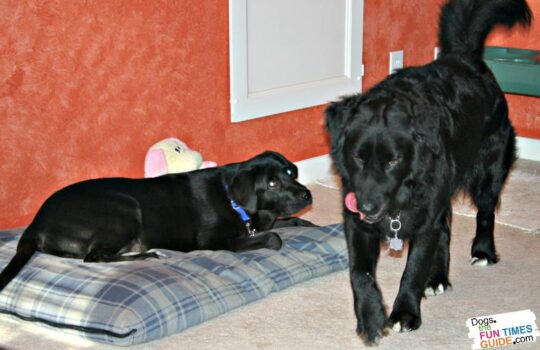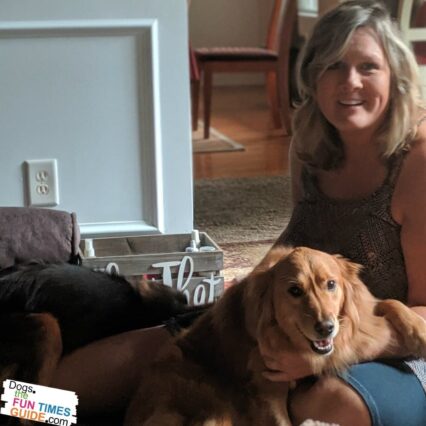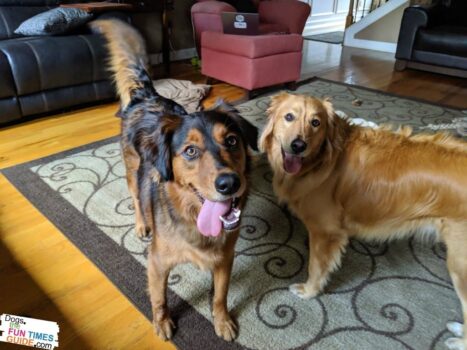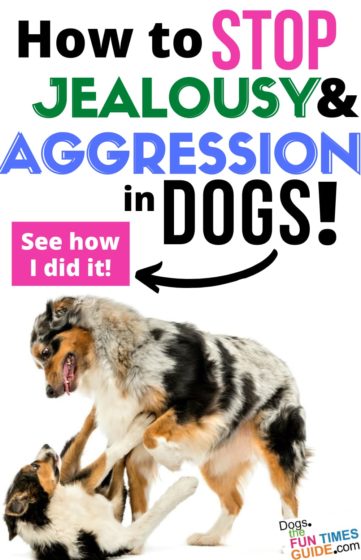We received a reader’s question about dog on dog jealousy recently. Which also brings up related questions like… “Why is my dog suddenly aggressive towards me but not my husband?” and “How to deal with a jealous dog?”
I think that many dog owners can relate, so I’m posting the original question and my answer here — to help you stop aggressive dog behaviors and jealousy issues before they get out of control!
We have just welcomed a 7-year-old Cavoodle (Peppa) into our home with our 8-year-old Jack Russell x Kelpie (Jacob). We did not expect how tricky this process would be. Your website is a very valuable resource.
Peppa is of course adjusting to a new home following some time in a shelter (and I’m not sure what sort of home she came from). She has some separation anxiety – which we are working on – I’m not sure if it is adjustment/decompressing or if this is a forever thing.
The other behavior is possessiveness. Of me. When I go to pat Jacob – she will lick her lips, shuffle, sometimes bark, or get in between Jacob and myself.
There was a recent incident (my fault – which involved a food-related toy) which resulted in her attacking Jacob. I never want this to happen again, and it’s shaken my confidence. I don’t want to reinforce her behaviour, I want to ensure we (myself and partner) are ‘pack leader’ – but I also want her to settle in and reduce her anxiety.
Do you have any resources about how I can a) read her triggers and b) respond to them to enable me to give attention to both dogs? Thanks in advance, I really appreciate your time.
–Lisa
Here’s my response for Lisa and others who find themselves in the same boat…
I believe that Lisa asked her question after reading the tips for aggressive dogs that I shared in this article back in 2007.
What To Do When One Dog Is Aggressive With Another
I know how challenging raising two dogs together can be — especially when one is jealous and/or aggressive. It’s downright scary at times!
I’ll be honest, I wish that we had consulted with a dog trainer to ease the process of raising those 2 dogs that I wrote about in my earlier article — because things got so bad that we were on pins and needles for many months (any time they were in the same room together).
A professional dog trainer would have relieved our stress, eased our minds, and solved the problem much more quickly than us doing it on our own. It felt like it took us ages to get to the point where the older dog would tolerate the younger dog. There was so much trial and error.
Most times, they were fine together. But then when you’d least expect it, our older dog would just snap.
I know, for sure, that one thing we did not do correctly was the way we chose to introduce the two dogs.
Since the older dog was always so loving and playful with us and with other dogs, we decided to bring the new puppy into our house and let them get to know one another on our living room floor. WRONG! Do not do this.
New dogs must always be introduced to one another on neutral territory — ideally outdoors. Instead, we mistakenly “forced” our older dog to get to know the new puppy on his own turf (in his own home) — where he had no say in the matter and he didn’t particularly want anyone invading his territory.
When things weren’t going well on our living room floor, we took the dogs outside to the backyard. That helped a little — but the older dog’s dominance characteristics had already set in. He wasn’t comfortable with this change to “his world”.
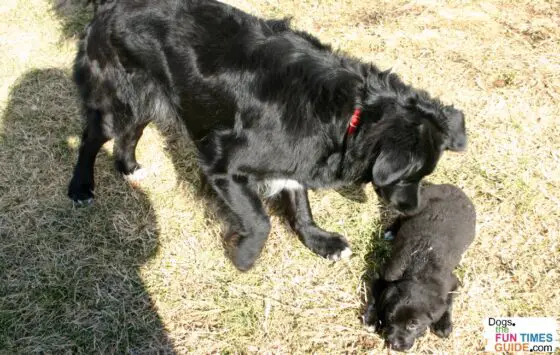
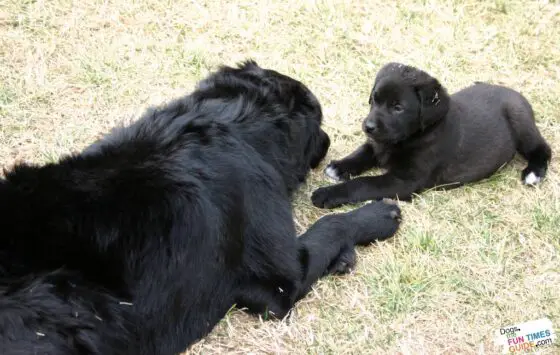
And thus began many long months of sibling rivalry of the worst kind.
What Do Dog Jealousy & Aggression Look Like?
Both of the dogs I wrote about in that article have passed. At the time, our jealous/aggressive dog was 5 years old when we got the 8-week-old puppy — both were Lab mixes.
The older dog’s backstory is… we found him under a dumpster as a tiny puppy, nursed him back to health, and he spent his first 5 years in our home with absolutely no issues. In fact, when we adopted him, he got along great with our then 11-year-old American Eskimo, and they never once had any issues together.
I never 100% figured out the dominant dog’s triggers around the new puppy. But mostly, it seemed that he would snap any time the younger dog would: a) act “weak” or 2) not respect the older dog’s pack status.
These were incredibly hard to pick up on in the milliseconds before the older dog would snap — because it happened so quickly!
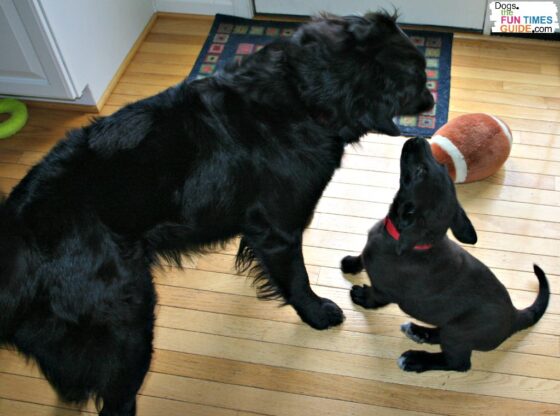

I noticed that each time before the older dog snapped at the younger one, he would:
- Cock his head sideways, as if to ask the younger dog, “Are you sure you wanna do that?”
- Raise his tail super high and stand still, as if to get the younger dog to “check up” and submit to his dominance.
Fortunately, I learned a lot from that experience 13 years ago. And I’ve also learned a lot after that… with my other dogs.
We now have 2 sibling pups (from the same litter) — and they too have some jealousy issues that we’ve had to deal with. But nothing as serious as the sibling rivalry we experienced with the first two. We got them at 8 weeks of age. They’re now 2-1/2 years old:
One has always been very dominant over the other one. And no, we’re not just talking about “rough play” between 2 dogs — that’s harmless and to be expected. You can tell that rough play is consensual if the 2 dogs remain together and interact.
This video shows our 2 pups playing rough together:
Yes, I was nervous about their rough play at first. But after speaking with a couple of veterinarians, they assured me that rough play is not aggression or anything to worry about. Now, looking back 2-1/2 years, I can laugh at the fact that I thought it might be aggressive dog behavior.
However, as a result of living with these 2 jealous dogs, I’ve learned even more valuable gems regarding “pack behavior”.
For example, the female dog is clearly more dominant than the male dog — evidenced by:
- Her constant nipping at his back legs
- The girl dog’s repeated mounting behavior
- Her frequent bossy barking directly at him
- The girl dog constantly “pushing” in between him and I or between him and other dogs
The submissive male dog also show signs of jealousy at times. His most common sign is an aggressive mounting behavior whenever he wants the female dog to:
- Stop playing with a certain toy
- Stop getting hugs or attention from me
- Stop hogging the best sleep spot in the house
These next 2 pictures show what it was like when I was training my dogs to “get on the box” in order to receive a treat.
The goal was to send them “to the box” whenever someone knocked on the door or the doorbell rang — to keep them both calm and from running out the door.
Soon, they both wanted to be on the box — because they got a treat for it.
Here, each dog is learning the “wait,” “first,” and “share,” commands to teach them patience:
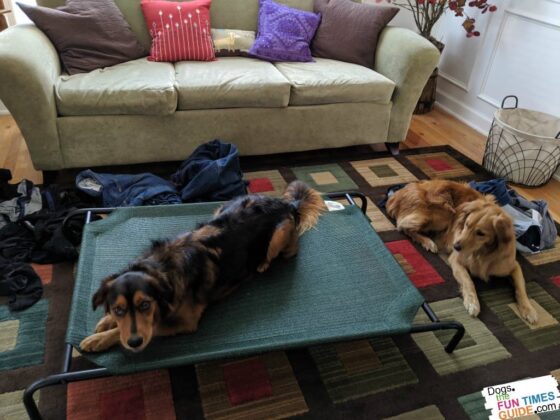
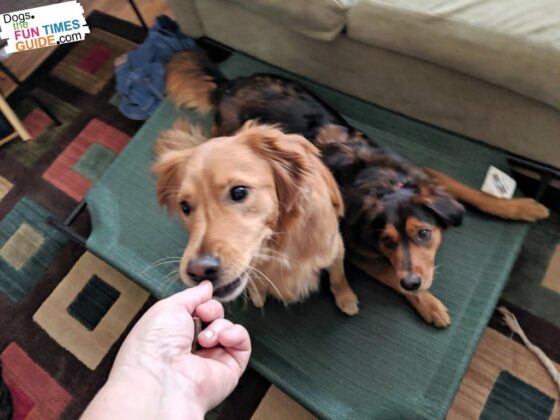
(Please ignore the piles of laundry on the floor — I was in between loads!)
Examples Of Dog Play: With And Without Jealousy
This video is an example of the girl dog controlling her jealousy. The boy dog has a bone that she wants. In the past, she would just take it away and they would bicker about it. But now, using the tips outlined below, she has learned to wait patiently for her turn:
Here’s an example of their bickering. It used to scare me at first, but now I know that dog play like this is completely harmless:
Here’s proof that they can sort out their problems alone now — even when a treat toy is involved:
And here’s what it looks like when the dominant dog just wants to play:
How To Get Your Dog To Respect & Listen To You
NOTE: I’m not a fan of alpha dog training methods. I primarily use positive reinforcement for my dog training methods. But I do believe in instinctual dog behavior. And it’s a fact… my dogs do respect me and mind me better when it’s clear to them that I’m their “boss” (and the one who provides the treats during our positive reinforcement training sessions). So that’s the type of thing I mean whenever I personally refer to “pack” behavior and “alpha dog” training in my own household.
My first piece of advice is: do not second-guess yourself when training your dogs. Stay firm and consistent with how you behave around your dogs — separately and together.
Dogs can sense your fear and stress. Trust me! And they will challenge you — especially a very dominant dog who has already shown a tendency to snap at another dog (or at you).
A pack leader (you, at home with your dogs) doesn’t show fear. They show controlled calmness. And as a result the pack leader will eventually earn the respect of the other dogs in the pack. And you will eventually have well-behaved dogs.
These confusing dog behaviors (aka “pack behaviors”) that result in signs of aggression often come down to the dominant dog simply being jealous of the other dog. Makes sense, right?
I also found this advice hugely beneficial:
The key to stopping bad behaviour isn’t “asserting dominance”, but rather cutting out rewards for behaviours you don’t like in your puppy, and making sure you do reward the behaviours you want to see more of. Verbal or physical punishment will only make your puppy think they ought to be scared of people, which could make them much more aggressive as they grow up. So, when training your puppy, ensure you reward behaviour you want to encourage, and ignore misbehaviour. Remember that any kind of attention is a reward! Even saying ‘no’.
—Victoria Stilwell, Dog Trainer
So, what can you do?
These are the best ways I’ve found to reduce the jealous behaviors between 2 dogs:
- Praise both dogs every time they play nice together.
- Use ‘happy talk’ to show that you like when they play well together.
- Reward both dogs with treats occasionally for their nice play behavior.
- Reward the dominant dog whenever they listen to the submissive dog’s requests to back off.
- Never let the dogs compete for your attention. If you’re petting one and the other cuts in, don’t reward that behavior by petting. Instead, ask them to sit and wait for their turn.
When your dogs see that they get rewarded for nice play time together, they will actually do it more often.
How To Stop Dog Jealousy & Aggression, Step By Step
I’ve successfully taught my 2-1/2 year old sibling pups to “wait their turn” whenever it comes to things they want — like getting hugs, going outside, getting to play with a toy, getting a treat first, etc.
It wasn’t something that happened overnight, but I feel it has helped tremendously with the ongoing jealousy issues between them. (And I wish I had done this better with our previous dogs — but things just got out of control so quickly with those two.)
How did I do it? Not by exerting dominance over them or scaring them or making them fearful of me — but simply by using 3 simple phrases with them consistently.
The 3 phrases I use consistently with my dogs that put me in full control of the situation (instead of them) are:
- “Share” – which basically just means that Dog A has to take a step back and does not get whatever it is they want at the moment — that Dog B is getting.
- “First” – which makes it clear that I’m intentionally “favoring” one dog over the other by allowing Dog A to get something or do something — before Dog B gets to.
- “Wait” – which means have a seat and wait until I give you the signal that you can get something fun or do something fun — I’m calling the shots here, not you.
How To Deal With A Jealous Dog: Examples + Tips
#1 – “No, Dog A…. you share the ___.”
TIP: Make it super obvious that you are physically giving the toy/hug/petting/food/treat to Dog B and that you are physically interacting only with Dog B at the moment. (All the while, continually praise Dog A for waiting patiently the entire time.)
#2 – “No, Dog A… Dog B first.”
TIP: Make Dog A sit and wait patiently for their turn. (I was so consistent with this one that my dogs actually sit and wait to hear who gets to go outside first each time now — I always switch it up.
#3 – “Dog A… wait.”
TIP: Make it clear that Dog A is expected to turn off that excited feeling about whatever it is they are wanting at the moment and sit right where they are and wait patiently until you say “okay”. (Only after you say “okay” can Dog A can fully interact with you and/or Dog B.)
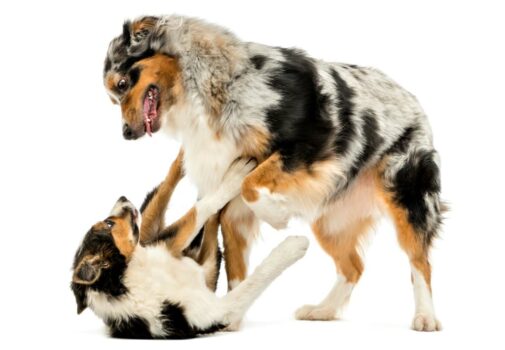
That’s how I have consistently used those 3 phrases with my sibling pups. And they work!
At this point, now I only have to look sternly at the dog that’s acting like a bully and they will usually stop what they’re doing right away.
I still give treats on occasion for random good dog behavior (like when they stop doing a behavior when I look at them sternly).
I think this is part of the magic — because my dogs never quite know when they’re going to get a “reward”. And they’ll do almost anything for a treat… no matter how small.
The Bottom Line
Do dogs get jealous? Yes.
Your dog may become jealous and/or possessive of another dog… or of your own attention.
So, if you’re wondering, “Why is my dog being so aggressive all of a sudden?” the above tips should help.
A dog’s increasing jealousy (and aggressive behaviors) are a sign that they’re confused about who is the “boss” — and a dominant dog will naturally step in to become the boss when no other boss is present.
Don’t give up too easily. A lot of time and patience is required but 2 dogs can learn to get along!
In summary…
If your dog is aggressive towards other dogs (or towards someone or something that gets in between you and that dog), I would encourage you to do the following:
- Take control. Try to not let either of your dogs sense your feelings of stress or overwhelm at any time.
- Spend time with each dog separately. Do this in front of one another sometimes (like behind a baby gate) and out of view of the other sometimes (behind a closed door).
- Do not let one dog push their way in between you and the other dog or between you and another person. Remember, you call all the shots in your household, not them (using one of the 3 phrases above).
TIP: Do not physically push the dominant dog away — that will just rile them up and get them more excited or jealous. Instead, simply turn your back to that dog and ignore their behavior 100% at that moment. You shouldn’t give them any personal attention at all whenever they’re being dominant — because they’re trying to get you to “cave” — to give in to their desire for attention. (Either good or bad attention, it doesn’t matter. They just want your attention.) And… if it works for them and they do get your attention, then they’ll continue to do it. On the flip side, the more times in a row that same jealous or aggressive behavior doesn’t work for them, then the less they will continue to do it!
Finally, all of this happens in baby steps.
For example, only make a dog “wait” for say, 5 seconds or something really quick — followed by lots of praise for waiting. Until they know what a particular command like “wait” really means, you can’t expect them to do it for very long at all at first.
Here is an excellent book that is helpful when dealing with jealous and aggressive dogs:
Fired Up Frantic and Freaked Out
Like this post? Save it to read again later… or share with others on Pinterest!
I like to help Dog Parents find unique ways to do things that will save time & money — so I write about “outside the box” Dog Tips and Dog Hacks that most wouldn’t think of. I’m a lifelong dog owner — currently have 2 mixed breed Golden Aussies that we found abandoned on the side of the road as puppies. I’ve always trained my own dogs and help friends train theirs, as well. Professionally, I worked at a vet and have several friends who are veterinarians — whom I consult with regularly. (And just because I love animals so much, I also worked at a Zoo for awhile!) I’ve been sharing my best ideas with others by blogging full-time since 1998 (the same year that Google started… and before the days of Facebook and YouTube). My daily motivation is to help first-time dog owners be better prepared from the first day your new puppy enters your home. I like to help dog owners understand what’s ‘normal’ and what you can expect in terms of living with and training your dog — how to get through the ups & downs of potty training, chewing, teaching commands, getting your dog to listen, and everything else that takes place during that hectic first year! When I’m not training, walking, grooming, or making homemade treats for my dogs, you will find me at the corner of Good News & Fun Times as publisher of The Fun Times Guide (32 fun & helpful websites). To date, I’ve written over 600 articles for dog owners on this site! Many of them have upwards of 200K shares.

